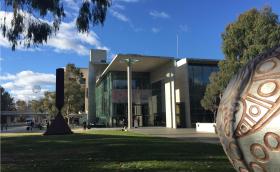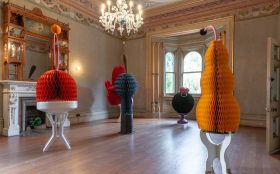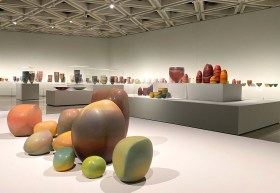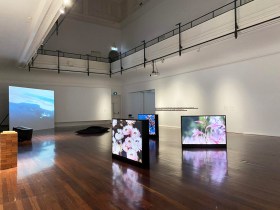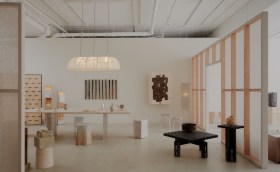The exhibition of street stencils, posters, stickers, paste-ups and hand-made zines was opened by University of Queensland Director Dr Campbell Gray, who was quick to mention that the timing of a street art exhibition in Brisbane was particularly controversial, as it coincided with the delivery of the latest issue of the Brisbane City Council’s ‘Living in Brisbane’ newsletter, the lead story of which was the Council’s recent crackdown on graffiti.
The responding nervous laughter of the attending crowd proved that the line between street art and graffiti is still as blurry as if it came straight from a can of spray-paint itself; however the overall emphasis on the opening was that the works displayed in Space Invaders have had both a cultural impact and significance over the past ten years that needed to be recognised.
This intention was quickly achieved, with a crowd that I assumed would be predominantly composed of young rebels actually proving to be a strong mix of age groups, including a scattering of grey-haired men in suits and women in pearls; proving that even older generations who did not grow up with the street art subculture are now acknowledging it as a genuine art form.
The artworks were an eclectic mix of framed and unframed works cluttered onto white walls peppered with stickers, some even peeling off the walls as if they were ageing on a city street. While there were the standard gallery-issued televisions showing the creative processes behind street art and artworks safely enclosed in glass cases, there had been an obvious attempt at representing the artworks as faithfully as they would be in a laneway or city wall.
There were no didactic panels next to the artworks to identify the work or the story behind it. Instead, visitors could take a booklet listing each work and its artist, but on more than one occasion I heard people (obviously those who had not picked up an exhibition booklet) asking each other who created a particular work or where it was from.
Admittedly, when viewing street art in its original location there is no elegantly typed foam-core didactic panel alongside explaining who designed a specific paste-up and what the story is behind its cartoon curves or stencilled letters, but I got the feeling that the regular gallery visitors had been trained to look for this information, and felt conflicted in being presented with such challenging work with very little explanation.
However, this adaptation from city street to art gallery has allowed Space Invaders to put an integral message of street art into action: that you have the freedom to look at the world around you and make up your own mind.
Space Invaders
A National Gallery of Australia exhibition
The University of Queensland Art Museum until Sunday June 5, 2011
RMIT Gallery, Melbourne: September 1 – November 5
Western Plains Cultural Centre, Dubbo: November 18 – March 18, 2012.


